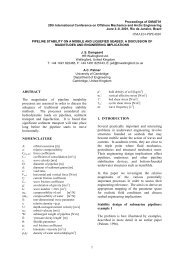Cantilever-like micromechanical sensors - Artek
Cantilever-like micromechanical sensors - Artek
Cantilever-like micromechanical sensors - Artek
Create successful ePaper yourself
Turn your PDF publications into a flip-book with our unique Google optimized e-Paper software.
Rep. Prog. Phys. 74 (2011) 036101 A Boisen et al<br />
Figure 21. Measured change in mass of a cantilever exposed<br />
to T5 phages. The blue filled squares and red filled triangles<br />
correspond to two different measurements with liposome/membrane<br />
receptor coated cantilevers. The green open triangles and black<br />
open squares correspond to two negative controls where the<br />
cantilevers have been coated with casein [238].<br />
Figure 22. Measured differential cantilever deflection when<br />
vancomycin binds to vancomycin resistant peptides (DLAC)<br />
and to vancomycin sensitive (DAla) peptides [23].<br />
sensitivity and at clinically relevant concentrations in blood<br />
serum. Also, from the measurements it was possible to<br />
quantify the binding constants for vancomycin-sensitive and<br />
vancomycin-resistant mucopeptides. Figure 22 shows the<br />
response from cantilevers coated with either vancomycin<br />
resistant peptides ((DLAC)) or vancomycin sensitive peptides<br />
((DAla)). All measurements are differential and a polyethylene<br />
glycol (PEG)-coated cantilever is used as reference. The<br />
measurements are performed in serum and it is clearly seen<br />
that only the sensitive peptides bind the vancomycin.<br />
5.5. Explosives detection<br />
<strong>Cantilever</strong>-based <strong>sensors</strong> have been applied for trace detection<br />
of explosives. Such a miniaturized detector would be<br />
highly suitable for use in anti-terror efforts, boarder control,<br />
environmental monitoring and demining.<br />
The sensing approaches either rely on specific receptors<br />
for binding of explosives or on specific properties of the<br />
21<br />
explosives such as phase transitions. In the group of Thundat<br />
et al the explosives TETN and RDX have been detected<br />
in 10–30 parts-per-trillion levels using a gold-coated silicon<br />
cantilever functionalized with a SAM of 4-mercaptobenzoic<br />
acid [239]. The binding is semi-specific and recently Zuo et al<br />
have reported on increased specificity in the binding of TNT<br />
using a coating of 6-mercaptonicotinic acid (6-MNA) [240].<br />
Here the measurements were performed using silicon oxide<br />
piezoresistive cantilevers.<br />
Specific receptors for explosives detection are difficult<br />
to achieve and other receptor free possibilities have been<br />
explored. The cantilever can be highly sensitive to temperature<br />
changes and can thus be used for photothermal deflection<br />
spectroscopy [14]. When a material absorbs a photon,<br />
a fraction of the energy may be transformed into heat.<br />
A measurement of photothermal heating as a function of<br />
wavelength can provide an absorption spectrum of the material.<br />
The principle was first illustrated by Barnes et al [14] using a<br />
silicon nitride cantilever coated with a thin layer of aluminum.<br />
Heat changes of the order of picojoules were detected, in the<br />
investigation of, for example, fluorecein molecules. Later, the<br />
technique was applied in explosives detection [241, 242].<br />
In another approach local differential thermal analysis<br />
(DTA) is used for the speciation of explosives. In DTA<br />
the material under study and an inert reference are made<br />
to undergo identical thermal cycles, while recording any<br />
temperature difference between sample and reference. As<br />
explosives are heated rapidly they will undergo decomposition<br />
and/or deflagration. These phase transitions can be used to<br />
achieve a thermal fingerprint of the explosives. Micrometresized<br />
cantilevers and bridges are ideal structures for DTA<br />
because of their low thermal mass. Micrometre-sized bridges<br />
with integrated heaters have been developed and used for<br />
the detection of explosives such as TNT, PETN and RDX<br />
[243–245]. The heater elements heat the bridge to around<br />
600 ◦ C. If explosives are present on the bridge these will start<br />
to evaporate or burn. In both cases the temperature of the bridge<br />
will change either because of evaporation or because of a local<br />
burning of explosives. This temperature change is measured by<br />
an integrated resistor which changes its resistance as a function<br />
of temperature change. The differential thermal response<br />
from bridges with and without adsorbed explosive vapour<br />
shows unique and reproducible characteristics depending on<br />
the nature of the adsorbed explosives. The method described<br />
is capable of providing unique signals for subnanogram<br />
quantities of adsorbed explosives within 50 ms.<br />
5.6. Material characterization<br />
Material characterization has always been an important issue<br />
in the field of microelectromechanical systems (MEMS).<br />
The properties of the used materials are process dependent<br />
and need to be known for a successful design. Standard<br />
mechanical material tests, such as the uniaxial tension test,<br />
to measure properties such as Young’s modulus and fracture<br />
strength are not suitable for the characterization of thin<br />
film materials. The needed test specimens are very fragile<br />
and difficult to handle and align. A solution is to design





